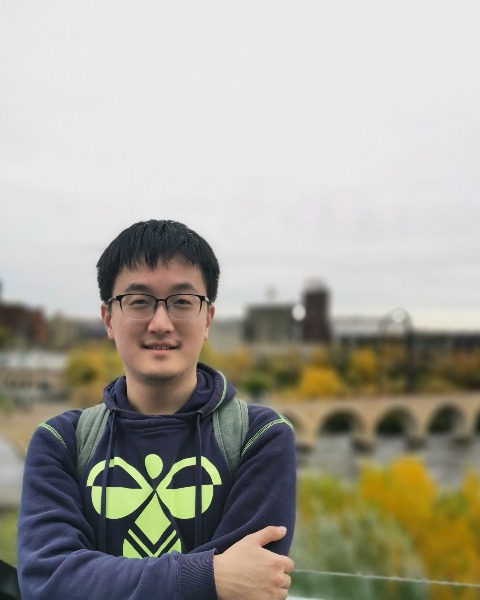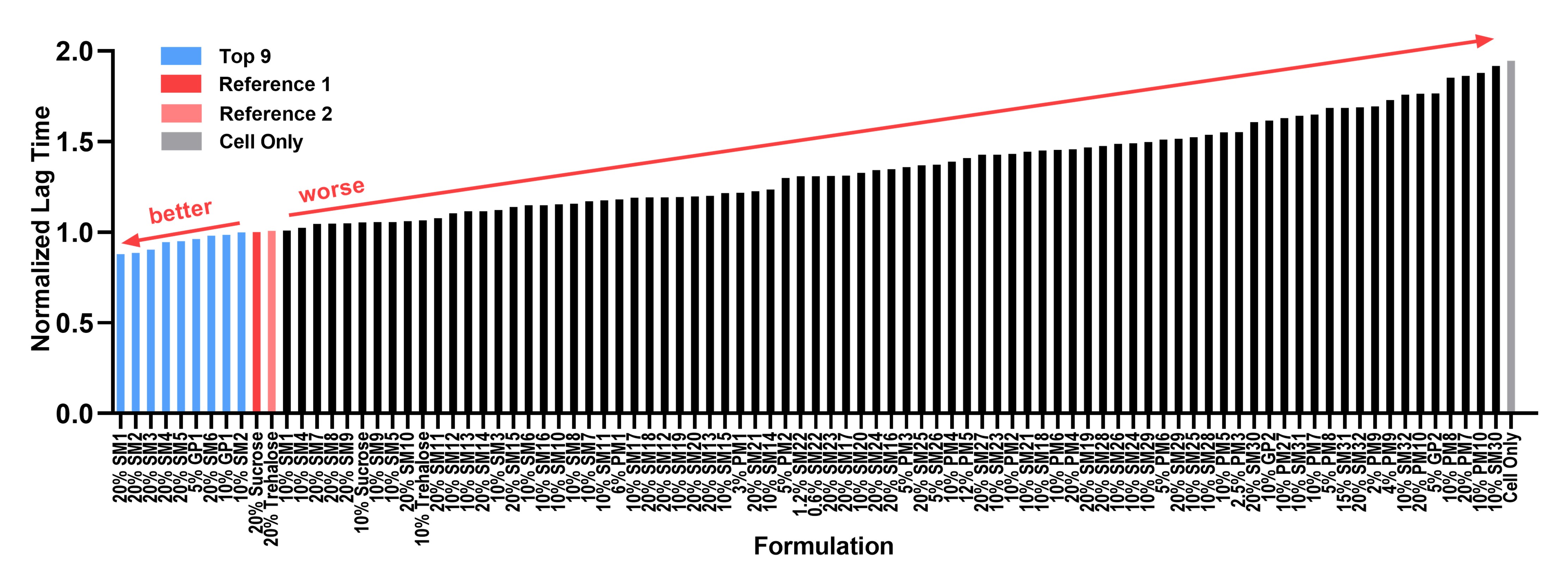Formulation and Delivery - Biomolecular
Category: Late Breaking Poster Abstract
(T1030-03-15) Expanding the Space of Hydroxyl-Rich Lyoprotectants through High-Throughput Screening to Support the Lyophilization of Yeast-Based Therapeutics
Tuesday, October 24, 2023
10:30 AM - 11:30 AM ET

Haixi Cui, B.S. (he/him/his)
PhD candidate
University of Maryland Baltimore
Baltimore, Maryland, United States
Haixi Cui, B.S. (he/him/his)
PhD candidate
University of Maryland Baltimore
Baltimore, Maryland, United States
Haixi Cui, B.S. (he/him/his)
PhD candidate
University of Maryland Baltimore
Baltimore, Maryland, United States- HY
Hua Yu, Ph.D. (she/her/hers)
FZata
Halethorpe, Maryland, United States - ZY
Zhiyong Yang, Ph.D. (she/her/hers)
FZata
Halethorpe, Maryland, United States - HF
Hanping Feng, Ph.D. (he/him/his)
FZata
Halethorpe, Maryland, United States - SH
Stephen Hoag, Ph.D. (he/him/his)
University of Maryland
Baltimore, Maryland, United States
Presenting Author(s)
Main Author(s)
Co-Author(s)
Purpose: Lyophilization preserves therapeutic cells for a plethora of applications, but poses risks to cell viability during freezing and drying. To mitigate these damaging processes in lyophilization, protective excipients, known as lyoprotectants, have been used. Lyoprotectants are known to substitute water molecules upon drying through hydrogen bond donated by hydroxyl groups (-OH). Currently, most research focuses on a limited number of disaccharides, including trehalose, sucrose, and lactose. Considering that different organisms have varying tolerance levels towards the lyophilization process, results and conclusions of these studies are usually species-specific and difficult to extrapolate. Thus, an efficient screening method is desired to find and consequently expand the repertoire of hydroxyl-rich lyoprotectants and customize the formulation for specific strains of interest. Herein, we report “growth monitoring” as a novel method for the high-throughput screening (HTS) of lyoprotectants for Saccharomyces Boulardii (Sb) (Figure 1a), a widely used probiotic yeast strain that promotes gastrointestinal health. Thereafter, we further probed a larger number of hydroxyl-rich lyoprotectants beyond the commonly studied excipients, and identified promising candidates for further exploration. Additionally, we discuss the characteristics that should be present in an optimal protective formulation for successful lyo-preservation of Sb cells.
Methods: A total of 47 hydroxyl-rich materials, including 35 small molecules (SM), 10 polymers (PM), and 2 glycosylated proteins (GP), were studied at both high and low concentration levels in aqueous solutions (Figure 2). These stock solutions are mixed with cell pellets (strain FZY12-G7-E1) harvested from YPD media after 22 hours of culture under 30°C at a 1:1 (cell pellets: protectant solution, v/v) ratio and allocated into glass vials or a 96-well cooling block before undergoing lyophilization, with the process consisting of a freezing stage of 180 minutes at -50°C, followed by a transition to primary drying with the ramping rate of 1°C/min to -36°C under 60 mTorr. Primary drying continues for 1440 mins before moving to secondary drying with the ramping rate of 0.1 °C/min to 30°C under 75 mTorr and kept for 360 mins. Cell viability is determined by dual staining with fluorescent diacetate and propidium iodide. For HTS, lyophilized samples are inoculated into YPD media on a 96-well culture plate at ~107 cells/mL, followed by monitoring the growth curves using OD600 under 30°C with continuous orbital shaking at 807 cpm. Growth curves are fitted using a 4-parameter logistic model to determine the growth lag time.
Results: For the development of the HTS method based on growth monitoring, growth curves of 5 Sb formulations were monitored (Figure 1a). Formulation performance is ranked by lag time normalized using 20% sucrose data. The lag time is defined mathematically as the time when the cell number doubles the bottom level. Pearson’s correlation analysis showed a strong negative association between lag time and cell viability, with a correlation coefficient of -0.98 (Figure 1b). n evaluating hydroxyl-rich materials, we identified 9 out of 94 formulations that outperformed the standard references (20% sucrose and 20% trehalose). Compared to Sb cell without excipient, all the screened formulations enhanced cell survivability upon lyophilization (Figure 2). Statistical analyses showed the superiority of small-molecule excipients over polymers (Figure 3a). Also, small-molecule excipients generally performed better at high concentration levels per screening range (Figure 3b), but such a trend was not observed for polymers (Figure 3c).
Conclusion: A 96-well-plate based novel HTS method is developed and utilized for the screening of lyoprotectants that preserved cell viability upon lyophilization. Our screening results boosted the arsenal beyond commonly used disaccharides to help cells withstand the stresses of lyophilization, and offered valuable insights for future research, highlighting the importance of exploring small-molecule sugars and polyols at high concentration levels (20% w/v). In addition, we will further investigate the use of HTS based on “growth monitoring” to enable customized formulation design for the successful lyophilization of other cell lines.
References: [1] Zhang, Y., Saint Fleur, A., & Feng, H. (2022). The development of live biotherapeutics against Clostridioides difficile infection towards reconstituting gut microbiota. Gut microbes, 14(1), 2052698.
[2] Rockinger, U., Funk, M., & Winter, G. (2021). Current Approaches of Preservation of Cells During (freeze-) Drying. Journal of pharmaceutical sciences, 110(8), 2873–2893.
Acknowledgements: This work is funded by R01AI148357-01 (NIAID).
 Figure 1. HTS method development. Lag time is the ranking parameter to evaluate different formulations. (a) High-viability lyophilized samples grew faster upon inoculation into YPD media. Lag time is labeled by green squares. (b) Linear regression shows lag time and viability are negatively associated.
Figure 1. HTS method development. Lag time is the ranking parameter to evaluate different formulations. (a) High-viability lyophilized samples grew faster upon inoculation into YPD media. Lag time is labeled by green squares. (b) Linear regression shows lag time and viability are negatively associated. Figure 2. 94 formulations were screened and ranked by normalized lag time. All the screened formulations performed better than the negative control, consisting of Sb cell only (gray). 9 out of 94 performed better than the standard references (20% sucrose, red, and 20% trehalose, pink).
Figure 2. 94 formulations were screened and ranked by normalized lag time. All the screened formulations performed better than the negative control, consisting of Sb cell only (gray). 9 out of 94 performed better than the standard references (20% sucrose, red, and 20% trehalose, pink).  Figure 3. Investigations into attributes of a good formulation. (a) Small-molecule excipients result in significantly less lag time (b) The performance of each excipient under high and low concentrations are paired for comparison. Orange line indicates an excipient performed better at its high concentration level, while blue line indicates the opposite. Small-molecule excipients at higher concentrations demonstrate superior performance compared to those at lower concentrations per screening range. (c) No such trend is observed for polymers.
Figure 3. Investigations into attributes of a good formulation. (a) Small-molecule excipients result in significantly less lag time (b) The performance of each excipient under high and low concentrations are paired for comparison. Orange line indicates an excipient performed better at its high concentration level, while blue line indicates the opposite. Small-molecule excipients at higher concentrations demonstrate superior performance compared to those at lower concentrations per screening range. (c) No such trend is observed for polymers.